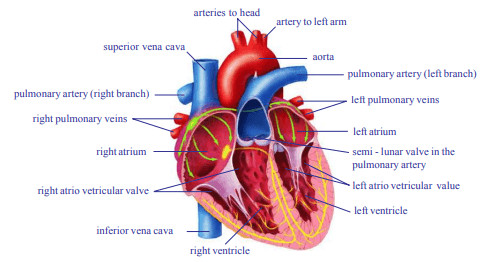The circulatory system is the system that circulates blood and lymph throughout the body. It supplies oxygen and nutrients to the cells and removes waste products. The AP Class 10 Biology chapter 3 Transportation, discusses the circulatory system in humans and plants in detail.
Human Heart

- The human heart is pear-shaped and triangular in outline, wider at the anterior end and narrower at the posterior end.
- The heart is covered by two membranes known as pericardial membranes.
- The heart is divided into four parts by grooves as atria (auricles) and ventricles. Auricles are the upper two parts and ventricles are the lower two parts.
- Six blood vessels are attached to the heart. The two rigid blood vessels are arteries, which supply blood to body parts aorta and lungs and pulmonary artery
- The right side of the heart receives blood from the body and sends to lungs
- The left side of the body receives blood from the lungs and send it to body parts.
- One contraction and relaxation of the heart is called cardiac cycle
In the next section, let us look at a few chapter questions to better understand the concepts discussed in the chapter.
Class 10 Biology Chapter 3 Transportation Questions
- What are the three main types of blood vessels in the body?
Solution:
The three main types of blood vessels in the body are:
- Arteries
- Veins
- Capillaries
2. How can you prove that the water is transported through the xylem?
Solution:

Aim: To observe the path of water through a plant.
Apparatus: Balsam plant, Beaker, Eosine solution, stand
Procedure:
- A leafy green shoot of a Balsam plant with a transparent stem is placed in an Eosine solution, as shown in the diagram.
- After a while, you will notice red streaks appear in the stem and veins of leaves.
- If a transverse section is cut through the root, stem and leaf, the tissue that has been stained is xylem tissue.
- This proves that the water moves up the root into the stem and leaves in the xylem tracheids and vessels.
- The other tissues remain in the same colour as its original colour.
Conclusion: From the above experiment, we can conclude that the xylem tissue is responsible for the upward movement of water through the plant.
3. What are two types of blood vessels?
Solution: There are two types of blood vessels called arteries and veins. Arteries carry blood from the heart to body parts and veins carry blood from body organs to the heart.
4. What is haemophilia?
Solution: Normally the blood that oozes from a wound clots in 3-6 minutes. But in some people due to vitamin K deficiency it takes more time. Because of genetic disorder the blood may not coagulate. This type of disorder is called haemophilia. Haemophilia is a common disorder in the children who have born from marriages between very close relatives.
Stay tuned to BYJU’S to get the latest notification on SSC exams, along with AP SSC model papers, exam pattern, marking scheme and more.
Comments